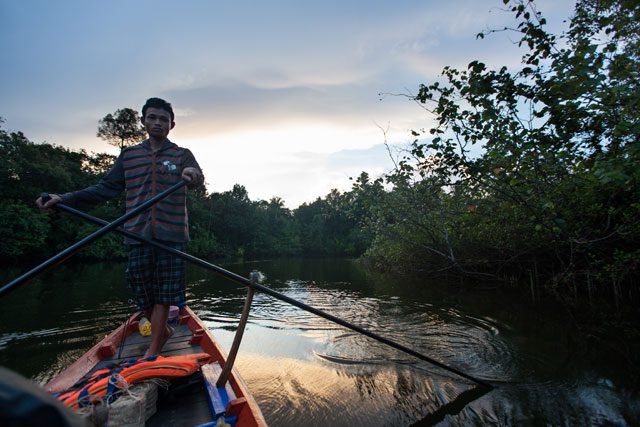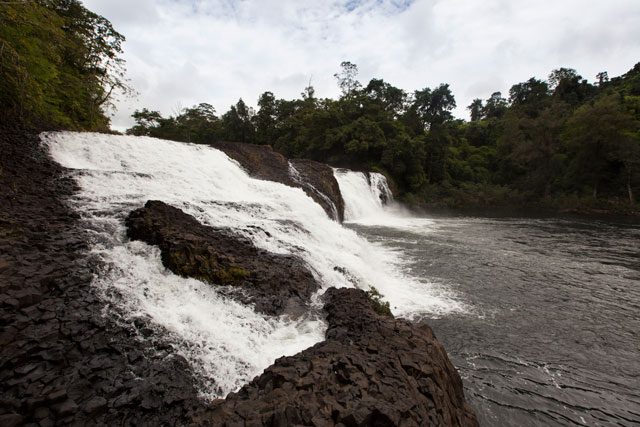Chi Phat is no walk in the park, but visitors prepared to rough it will be rewarded with an unforgettable travel experience
By Amanda Saxton Photography by Anne Holmes
We’re at the mercy of wiry young daredevils. Perched on the backs of their motorbikes, with no common language, we bound down narrow tracks crudely cut from the jungle, across Escher-esque bridges and through splashy boulder-strewn streams. Our chaperones-cum-chauffeurs exchange conniving grins, bouncing the bikes skillfully from one semi-solid lump of earth to another. Their motos, which possibly used to be sturdy Japanese Hondas, are now so ingeniously held together by string and kismet that Cambodia must be attributed with their continuation, if not their creation. Cambodian kismet is not always enough though; the motos cough and die a few times in particularly steep or submerged conditions. Cambodian muscles always manage to bring them back to life.

The 600-odd families of Chi Phat, a town in Cambodia’s Cardamom Mountains, remain unfazed by events in the outside world; even by their own country’s tumultuous recent election. Life is basic here: Parents work to feed their children, and children play with crabs on pieces of string. Chi Phat seems like the quintessential jungle village, a two-hour boat ride from Andoung Tuek that deposits visitors in a world of basic huts on stilts and a few gaggles of clucking chickens. So what explains these incongruous Westerners gripping to the back of a motorbike? Wildlife Alliance, an environmental NGO, established a community-based ecotourism (CBET) site here in 2008 that accounts for the growing number of international travellers trudging up from the Phi Pot river to one of the 23 guesthouses in this tiny town.
The NGO’s impetus was the illegal loggers and marauding poachers that ravage the Cardamom Mountains – an elephant corridor and home to Cambodia’s now critically endangered leopards, bears, dolphins and crocodiles. Wildlife Alliance felt that the rationale behind such activities was simply the need for locals to feed their families so, in 2008, it found an alternative source of income for Chi Phat’s villagers in the form of tourism. This mentality – encouraging the community to protect the environment rather than destroy it – is the foundation of CBET. Intrepid tourists who visit the area get a truly grassroots experience of a beautiful part of Cambodia.

The poster boy of the community is arguably the converted poacher Moa Sarun. His career has leapfrogged from logger, to hunter, to guide, to his current role as the CBET accountant in Chi Phat. Sarun describes the lifestyle of a poacher as so fraught with dangers – from getting arrested to being bitten by snakes – that regular work is preferable, if it is available.
Keeping the work flowing is how CBET helps the villagers. Be they cooks, guides, administrative staff, or guesthouse operators, virtually every adult works for the project, and the group pools their earnings. Most villagers haven’t ventured further than 30km from town, and its chefs have never eaten in restaurants. English teaching initiatives haven’t proven too popular, meaning barriers in both language and culture exist between guests and staff. Cambodian smiles are famed for leaping such barriers, however, and there are women in the visitor centre whose English is superb. These young ladies will arrange mountain bikes, motorbikes, kayaks, guides and packed lunches.
The destinations on offer are diverse, numerous and stunning. One can wallow in sun-drenched pools below the O’Malu waterfall, or absorb the sunset from Bald Mountain. Meander through shady bamboo grottoes that house immense kaleidoscopes of butterflies and poke around the ancient burial jar sites, which have intrigued anthropologists the world over. Go one further and camp in the jungle on a multi-day expedition, enjoying fire-cooked meals and cheeky primate companions.
The best way to get intimate with the jungle is to witness its waking rituals, far from those of the village roosters. To serenely glide down the Phi Pot river, from velvety darkness into the first glow of sunrise and then into full-blown daylight is a magical voyage. First, the looming riverbanks emerge from the mist, their dense vegetation indistinct shades of blue, creating multiple horizons reflected on the water’s smooth surface. Then, rays of light strike out, illuminating trees, patches of water, and occasionally the boat you’re riding in. At this stage, a sleepy hornbill or two may launch off a branch and flap across the river. All of a sudden everything turns gold and fuchsia as the sun shows its face and the dawn chorus erupts. Unfortunately, when proper daylight hits, you realise your rump is numb, the only birds you’ve seen are sleepy hornbills and a few sparrows, and you have a strange craving for three-in-one coffee.
After a long day exploring, it’s a good thing sleeping options are rife in Chi Phat. It seems every second building is a guesthouse and there’s an eco-lodge consisting of bamboo bungalows a kilometre or so out of the village over a swing bridge. Luxury they are not, but each does have its own bathroom and a beautiful riverside setting, snuggled among tall trees. Local ants, termites, moths and centipedes, all presumably on steroids, will enthrall budding entomologists. They preside over the stone paths between buildings, although their efforts to enter the bungalows are thwarted by netting secured beneath the floorboards. Guesthouses are in the village proper, providing comfortable yet basic rooms with shared bathrooms. Balconies overlooking the main drag allow views of snow-white cattle moving forward like ghosts. When it rains, village bath-time may also be observed; people rush outdoors with their slivers of soap to get ‘clean’ in the brick-red rivers that rural Cambodian roads become in a deluge. Although the electricity isn’t extinguished until about 10pm, everything closes a few hours earlier. Bring a pack of cards or a good book, and a torch if you’re a night owl. My colleague and I had a riotous time playing backgammon and comparing leech damage beneath our pink mosquito net.
Ah yes, the leeches. They are an inescapable feature of Chi Phat. They are essentially stretchy, featureless, black tubes, only one to three centimetres long, with a sucker on each end. Their ability to reach bikini lines beneath tight trousers when toilet stops have numbered zero is almost admirable. Did it go up the leg? Down the torso? One may think a blood-sucking parasite gorging on oneself to be a horrifying experience. It’s painless. Leeches inject their victims with anaesthetic before they start their suck – how very courteous of them. If you don’t want to share your blood, scrape them off with a fingernail, although insect repellent will stop them biting in the first place. Traditional means of dislodgement such as salting or burning actually causes leeches to vomit into the wound. Mercifully, we are assured they are virtually harmless, whether sucking or vomiting.
Chi Phat is not for sissies. It’s for rugged adventurers that delight in intercultural quirks and encounters with nature. Handle the leeches; you’ll be rewarded with breathtaking vistas. Handle the linguistic hurdles; you’ll be rewarded with radiant hospitality. But don’t expect to meet elephants in the jungle – the only one we spied was at a highway petrol station, viewed through a bus window.
Also view:
“Saddle up” – Fill up that water bottle, buckle up that helmet and get pedalling through Myanmar’s glorious scenery
